Before you start winterizing your standby generator, make certain you conduct a full load and system performance test, inspecting all external and internal components. Check fuel and oil levels, replace filters, and address any leaks or damage, especially in cold weather. Inspect the battery and install necessary winter equipment like block heaters. Clear debris and snow from vents and surrounds, ensuring proper airflow and safety. If you continue, you’ll discover detailed steps to make sure your generator runs reliably all winter.
Key Takeaways
- Perform a full load test and external inspection to ensure generator readiness before winter use.
- Check and top off fuel and oil levels, and inspect for leaks or contamination.
- Test and maintain the battery, installing cold weather equipment like heaters if necessary.
- Clear debris, snow, and obstructions from vents, intake, and exhaust areas for safe operation.
- Review safety protocols, ensure proper ventilation, and verify all connections and components are secure.
Conduct a Full Load and System Performance Test
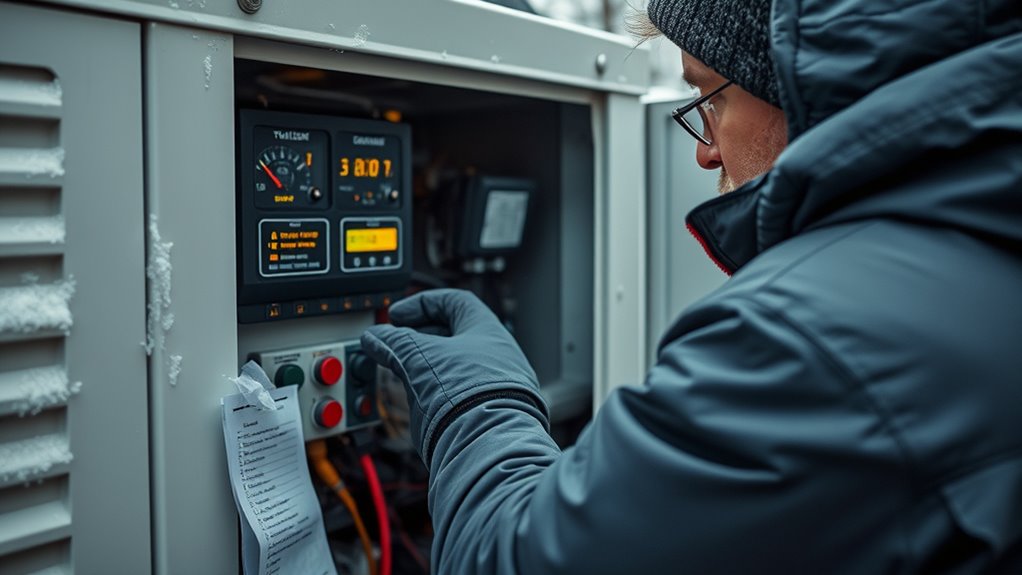
To guarantee your standby generator is ready for an emergency, you should conduct a full load and system performance test. Start by running the generator and letting the engine coolant temperature stabilize at normal operating levels. Transfer the transfer switches to the emergency source to simulate a power outage. Use a load bank to apply incremental loads—25%, 50%, 75%, then 100%—holding each stage for specified durations, such as 30 minutes or an hour. During testing, monitor key metrics like voltage, frequency, oil pressure, coolant temperature, and exhaust gas temperature to ensure they stay within safe limits. Resistive load testing helps verify if the generator can produce its full power output at 1.0 power factor with full kW load, ensuring the system’s capacity and performance are adequate. Gradually remove the load, transfer back to normal power, and allow the generator to cool. This process verifies the generator’s capacity, identifies weaknesses, and helps prevent operational issues during actual emergencies. Additionally, performing system diagnostics ensures all components are functioning correctly and can handle the expected loads.
Replace and Inspect Air and Fuel Filters
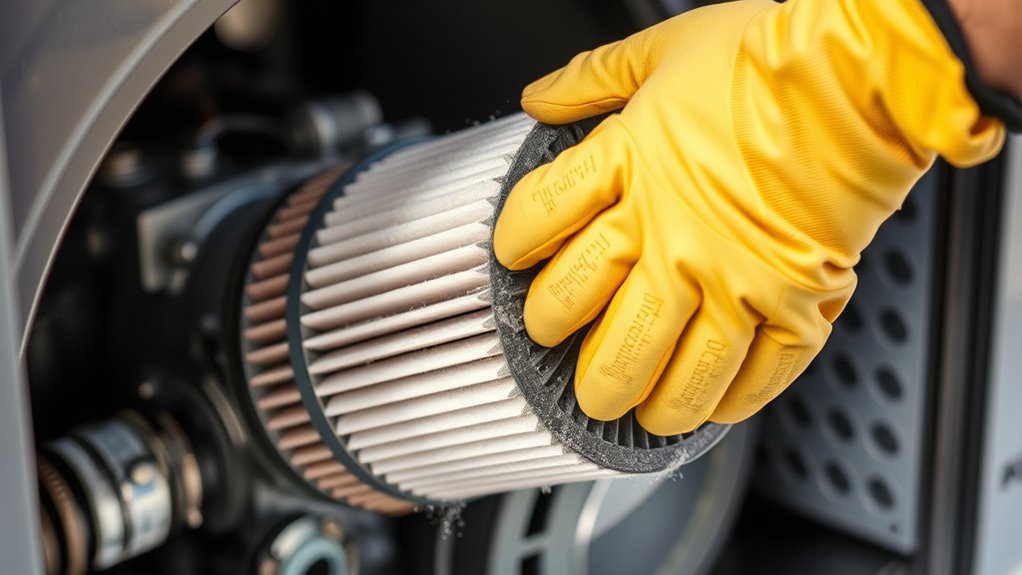
You should regularly inspect your air and fuel filters for dirt, debris, and signs of wear to guarantee ideal generator performance. When replacing filters, follow proper procedures to secure a snug fit and prevent air or fuel leaks. Keeping these filters in good condition helps maintain efficiency and prolongs your generator’s lifespan. Ensuring proper fitment is crucial to prevent potential issues during operation. Additionally, staying informed about Practical Support related to generator maintenance can help you address unexpected problems more effectively.
Filter Condition Check
Regularly inspecting and replacing air and fuel filters is essential for ensuring your standby generator operates reliably in winter. Cold temperatures can cause moisture and ice to build up, restricting airflow and impairing engine performance. To keep your generator in top shape, check your filters for clogging, frost, or dirt buildup. If you notice damage or excessive dirt, replace them promptly. Proper filter maintenance is crucial because dirty filters can lead to decreased fuel efficiency and increased wear on engine components. Here are three key points to contemplate: 1. Ensure filters are dry and free of ice—moisture can freeze and block airflow. 2. Inspect for damage or hardened material—cold exposure can weaken filter integrity. 3. Replace dirty or damaged filters immediately—prevent performance issues during power outages. Maintaining filter integrity guarantees smooth operation and reliable power when you need it most.
Proper Replacement Procedures
Proper replacement and inspection of air and fuel filters are vital steps in maintaining your standby generator’s reliability, especially before winter. Regularly check filters for tears, holes, or excessive dirt, replacing them when damaged or dirty beyond cleaning. Confirm gasket integrity on new filters and verify compatibility with your generator model. When replacing, locate the filter housing per your manual, carefully remove the old filter, and install the new one with a proper seal. Tighten all fasteners evenly to prevent air leaks. Use the table below to guide your process:
| Step | Tools Needed | Key Tip |
|---|---|---|
| Remove old filter | Screwdriver or latch release | Avoid debris contamination |
| Inspect filter | Visual check | Look for tears or moisture |
| Install new filter | Correct gasket placement | Ensure a tight seal |
| Reassemble housing | Tighten fasteners evenly | Prevent unfiltered air ingress |
Additionally, cleaning the filter at regular intervals helps prevent dust buildup that can hinder engine oxygen flow and reduce performance, extending the lifespan of your generator. Regular inspection of filters also helps identify potential issues early, ensuring your generator remains ready for winter conditions.
Check Fuel System Components and Fuel Levels
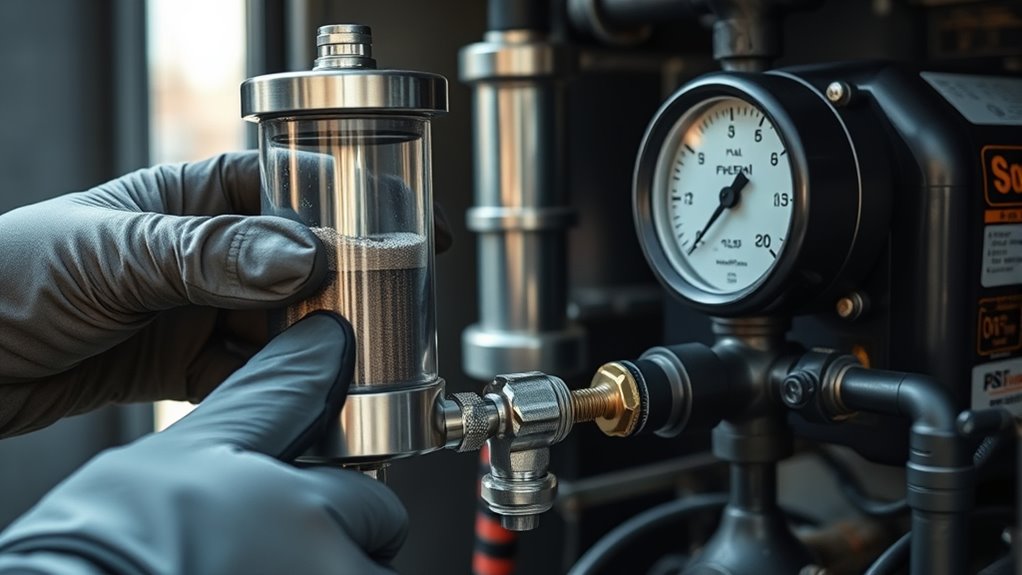
Making certain the fuel system is in good condition is essential for reliable generator operation during winter. You need to thoroughly check your fuel system components to prevent failures when you need power most. Inspect fuel lines for cracks, leaks, or brittleness caused by cold temperatures, and replace damaged sections. Check fuel filters for clogging or contamination, replacing them to maintain proper fuel flow. Verify the fuel tank is free of water and sediment, and ensure it’s topped off to reduce condensation and prevent freezing. Additionally, ensuring your fuel system is free of water contamination is crucial, as water can cause freezing issues and damage to the system during cold weather.
Inspect Battery Health and Install Cold Weather Equipment
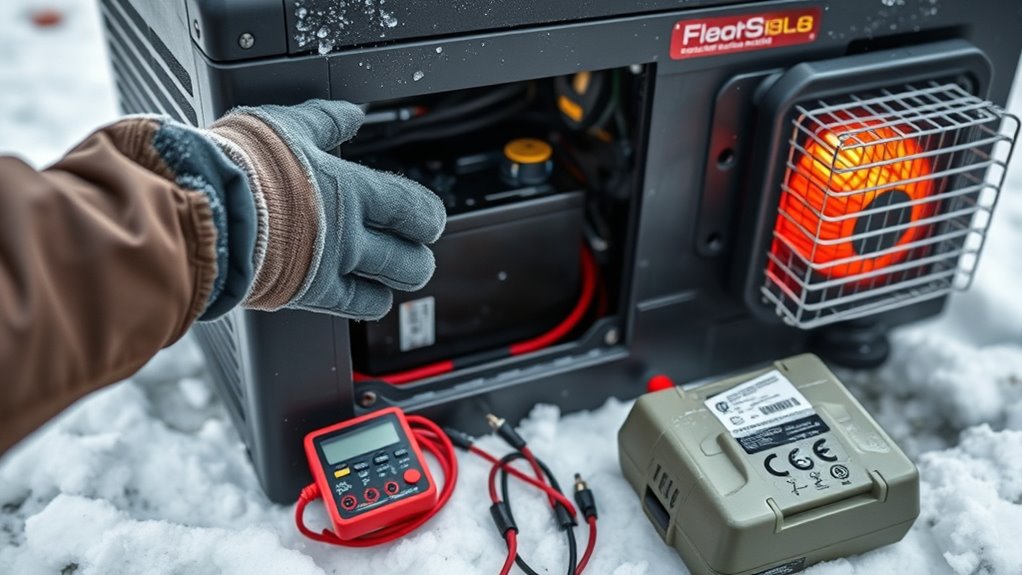
Cold temperatures can substantially reduce your generator’s battery efficiency, increasing the risk of startup failure when you need it most. To prevent this, test your battery’s voltage regularly to ensure it’s fully charged. Clean any corrosion from terminals for optimal electrical connection. If your battery is over three years old, consider replacing it for reliable performance. Installing thermostatically-controlled battery warmers keeps batteries above 40°F (4°C), boosting cold start chances. These warmers automatically activate, requiring no manual effort. Use the following chart to visualize cold weather equipment benefits:
| Equipment | Placement | Benefit |
|---|---|---|
| Battery Warmers | Under or attached to battery | Improves cold start reliability |
| Oil Heaters | Oil pan or crankcase | Prevents thickening, ensures lubrication |
| Block Heaters | Engine block | Keeps engine warm for startup |
Additionally, regularly inspecting the battery’s charge level helps identify potential issues early, ensuring your generator remains ready during winter emergencies. Incorporating proper maintenance practices can further extend the lifespan of your equipment and enhance overall reliability.
Perform a Physical Inspection and Clear Surroundings
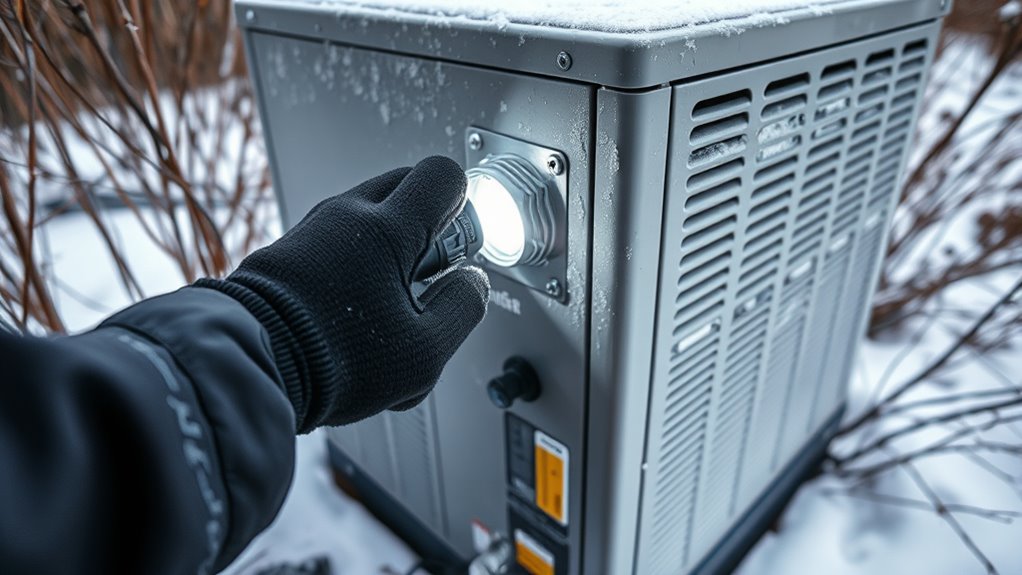
Start by inspecting the external components of your generator for damage, corrosion, or loose parts that could cause issues during winter. Next, clear away any debris, leaves, or obstructions around the unit to guarantee proper airflow and prevent blockages. Maintaining a clean, unobstructed area helps your generator operate safely and efficiently in cold weather. Regular inspections can identify potential problems early, ensuring your generator remains reliable throughout the winter months. It’s also beneficial to check for symptoms of wear that could indicate the need for repairs or maintenance.
Inspect External Components
Have you thoroughly examined the external components of your standby generator? Ensuring its exterior is intact is essential for winter readiness. Take these steps:
- Inspect the casing for dents, cracks, rust, or corrosion that may weaken the structure or cause leaks.
- Check bolts, nuts, and screws on the frame and housing, tightening any loose parts to prevent vibrations or damage.
- Examine belts, pulleys, and wiring for wear, fraying, or looseness that could lead to operational failures.
- Inspect the generator’s exterior for signs of pest intrusion or nesting, as debris or pests can cause blockages or damage during winter months. Regular exterior checks help maintain optimal function and prevent unexpected breakdowns when the weather turns severe.
- Additionally, verifying the weatherproofing of external components can prevent moisture ingress and corrosion, which are common issues during winter.
Also, look inside the battery compartment for corrosion or loose terminals, which are critical for reliable starting. Clearing debris and ensuring all external components are sound helps prevent emergency issues during winter storms and guarantees your generator operates smoothly when needed most.
Remove Debris and Obstructions
After inspecting the external components of your standby generator, it’s important to check that the surrounding area is free of debris and obstructions. Remove branches, leaves, and organic debris near the unit to prevent airflow blockages. Clear at least a 3-foot radius around the generator to ensure proper ventilation and prevent overheating. During winter, remove snow buildup from intake and exhaust vents to avoid blockages. Dispose of lawn clippings, dirt, and loose materials that could be blown or washed into the area. Inside the enclosure, clear leaves, sticks, and dirt to prevent internal obstructions and moisture retention. Regularly inspect for fallen branches, damaged tree limbs, or debris after storms. Keep vents and screens clean, and trim back nearby shrubs to maintain clear airflow and safe operation. Proper ventilation is essential for safe generator operation. Ensuring the area around your generator is free of obstructions and debris helps maintain optimal performance and safety.
Practice Routine Operation and Storage Procedures

Practicing routine operation and storage procedures is essential to guarantee your standby generator remains reliable when you need it most. Regular checks help identify issues early and ensure smooth performance during emergencies. Maintaining a consistent testing schedule also helps extend the overall lifespan of your generator by preventing corrosion and mechanical failures. Additionally, conducting regular inspections can reveal signs of wear or damage that might compromise safety or functionality. 1. Schedule periodic exercise runs during storage to prevent fuel degradation and engine seizure, giving you peace of mind. 2. Listen carefully for unusual sounds or odors during test runs to catch mechanical or electrical problems before they escalate. 3. Verify the battery’s condition, disconnect it if recommended, and turn off the main breaker and fuel valves after each test to prevent leaks and unintended operation. These steps keep your generator ready, safe, and in excellent condition, so you’re prepared when outages strike.
Ensure Proper Exhaust and Ventilation Conditions

Are you guaranteeing your generator’s exhaust and ventilation systems are properly configured? Properly directing exhaust gases, like carbon monoxide, away from occupied spaces is critical. Place exhaust fans vertically above the generator to effectively remove heat and emissions. Outdoor generators should be positioned in open areas, avoiding low-lying or enclosed spaces where exhaust can accumulate. Use separate ventilation systems for multiple units to prevent cross-contamination. Routinely check that vents and exhaust outlets are clear of snow, leaves, and debris, especially during winter. Make sure vents don’t freeze or block airflow. Maintain a clear three-foot perimeter around the generator for adequate airflow, supporting safe combustion and cooling. Regular inspections and proper routing help prevent overheating, toxic buildup, and ensure compliance with safety standards. Proper ventilation is especially important for generator tuning to optimize performance and safety.
Follow Safety Protocols During Maintenance and Operation
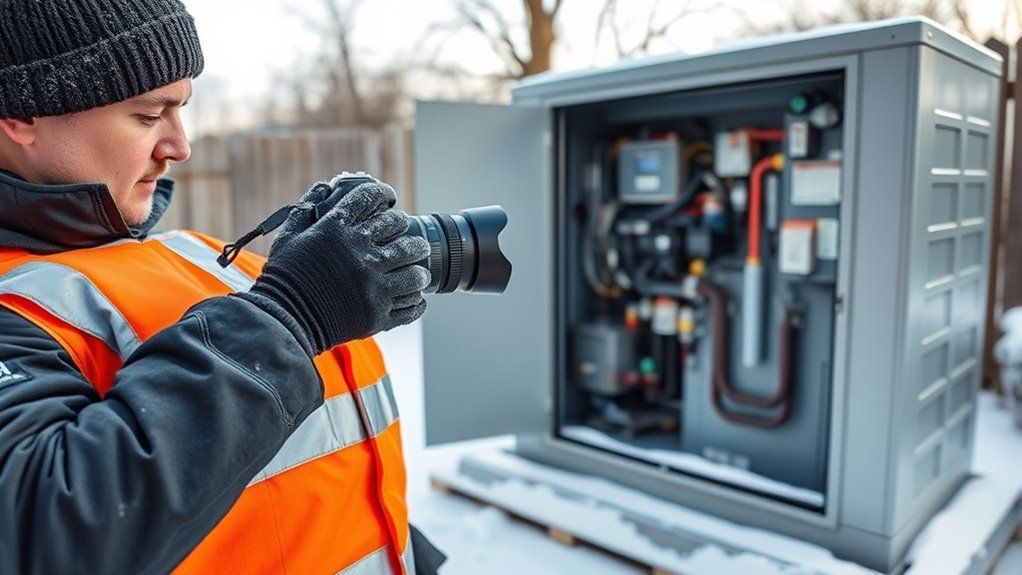
To guarantee safe operation of your standby generator, always follow essential safety protocols during maintenance and usage. First, ensure you’re working in a well-ventilated outdoor area, never inside enclosed spaces, to prevent carbon monoxide poisoning. Second, keep a minimum three-foot clearance around the generator, removing snow, debris, or obstacles that could block airflow or cause fires. Third, regularly inspect electrical connections, fuel lines, and transfer switches for damage or leaks, and use GFCIs where needed. Additionally, handle fuel carefully—let the generator cool before refueling and store fuel safely away from heat sources. Proper ventilation is critical because cold temperatures can cause exhaust fumes to linger, increasing the risk of carbon monoxide buildup indoors or in poorly ventilated areas. Being aware of essential safety protocols helps prevent accidents and ensures reliable operation during winter months. By adhering to these protocols, you protect yourself, your home, and everyone around you during winter operation. Safety always comes first.
Document Maintenance Activities and Schedule Future Checks
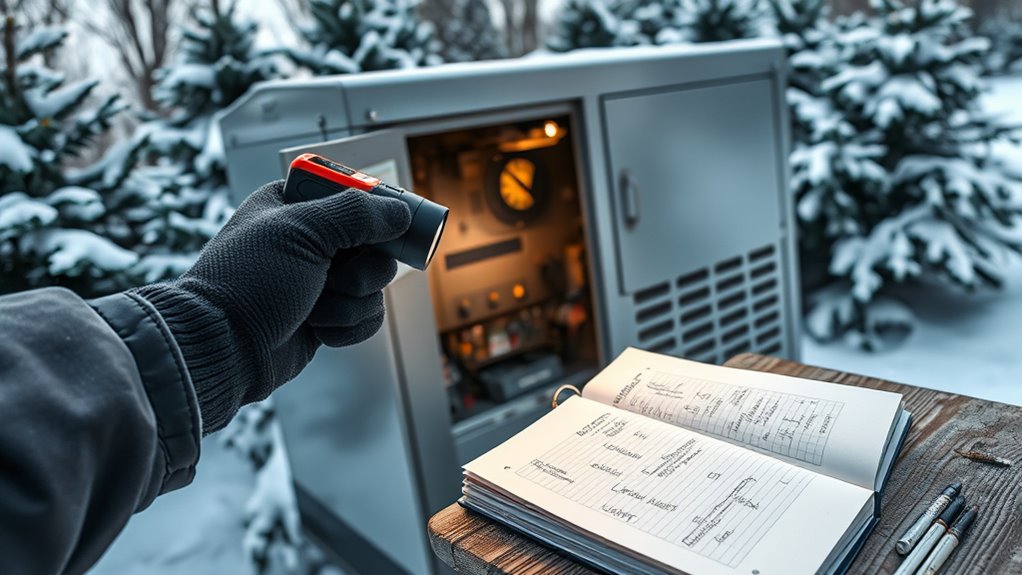
Keeping detailed records of your maintenance activities guarantees your standby generator stays reliable when you need it most. Accurate logs verify that all scheduled tasks, like oil changes, battery tests, and fuel checks, are completed on time. They help you track recurring issues, enabling early detection of systemic problems. Proper documentation also supports warranty claims and regulatory compliance. Be sure to record the date, time, tasks performed, observations, repairs, parts replaced, and technician’s name. Schedule future checks based on manufacturer recommendations, including monthly load testing, visual inspections, oil changes, and battery checks. Use digital logs, software, or physical binders to track these activities. Regular documentation ensures your generator remains operational, extends its lifespan, and minimizes unexpected failures when power outages strike. Additionally, maintaining comprehensive storage conditions records, such as proper fuel and oil storage, can prevent spoilage and ensure readiness during emergencies.
Frequently Asked Questions
How Often Should I Perform Load Testing on My Standby Generator in Winter?
You should perform load testing on your standby generator monthly during winter. This guarantees it operates reliably under cold conditions and helps identify potential issues like cold starts or freeze-related problems. Use winter-specific equipment like block heaters and cold-weather kits. Document every test thoroughly, and consider professional inspections to confirm your generator’s readiness. Regular testing in winter keeps your generator prepared for emergencies and prevents unexpected failures in cold weather.
What Are the Signs of Fuel or Air Filter Contamination?
Imagine your generator’s filters as essential gateways—when clogged, they signal trouble. You notice reduced power, rough idling, or increased fuel consumption for fuel filters, and for air filters, you see smoke, poor acceleration, or dirt accumulation. Both may emit strange odors or cause engine hesitation. If filters are blocked or dirty, your generator struggles, risking breakdown. Regular checks keep these gateways clear, ensuring smooth, reliable operation when you need it most.
How Can I Tell if My Battery Needs Replacement Before Cold Weather?
You can tell if your battery needs replacement before cold weather by checking for frequent alarms, corrosion on terminals, or physical damage. Conduct a load test and use a voltmeter to verify it holds a proper charge. If the battery is over three years old, shows signs of decline, or struggles during testing, replace it proactively to guarantee reliable starts during winter. Regular maintenance helps prevent unexpected failures when it’s cold outside.
What Safety Precautions Are Essential During Generator Winterization?
Think of safety precautions as your generator’s shield against winter’s hazards. You must keep it outside, away from windows, and clear snow and debris to guarantee proper airflow. Regularly inspect fuel, electrical connections, and vents to prevent leaks or blockages. Never operate it indoors or in enclosed spaces—carbon monoxide is a silent threat. By staying vigilant and following these steps, you protect yourself and ensure your generator runs smoothly all winter.
When Should I Schedule Professional Maintenance or Inspections?
You should schedule professional maintenance or inspections at least twice a year, ideally every six months, or every 400 run hours. Also, book an annual thorough checkup, especially before winter. If your generator runs frequently or shows signs of irregular operation, consider more frequent inspections. After severe weather or unusual issues, get a professional to assess and make certain everything functions properly, maintaining your generator’s reliability when you need it most.
Conclusion
Now that you’ve gone through this winterizing checklist, you’re well-prepared to keep your standby generator running smoothly through the cold months. Remember, even the most steadfast steed needs care—think of it as giving your trusty steed a good armor polish before battle. Regular maintenance ensures you’re ready for winter’s surprises, so don’t forget to document your work and schedule future checks. Stay vigilant, stay prepared, and let your generator be your reliable winter guardian.










